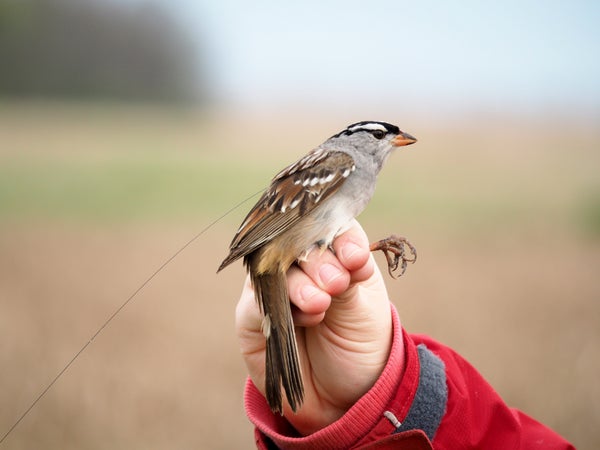One of the most widely used agricultural insecticides causes severe weight loss in white-crowned sparrows and delays the migration of these common North American songbirds, according to a new study published Thursday in Science. The finding suggests exposure to the pesticide could be contributing to declines in certain bird species over the past half-century, experts say.
The study examined the effects of imidacloprid, part of a class of neurological toxins called neonicotinoids used to target insect pests in farm fields. These chemicals, which can be directly applied to seeds and are absorbed into plant tissue as crops grow, were thought to be less toxic to vertebrates than other pesticides. When a neonicotinoid is applied to a seed, however, less than 20 percent of it will end up in the plant—and these pesticides are turning up in the environment. The chemicals have increasingly come under fire in recent years because their presence in the wild has been linked to losses of honeybee populations and implicated in birth defects among deer and other mammals.
“This [new] paper is a signal,” says Nicole Michel, a senior quantitative ecologist at the National Audubon Society, who was not involved in the study. “It’s the canary in the coal mine that says neonicotinoids are very bad for bird populations.”
On supporting science journalism
If you're enjoying this article, consider supporting our award-winning journalism by subscribing. By purchasing a subscription you are helping to ensure the future of impactful stories about the discoveries and ideas shaping our world today.
The researchers who conducted the research previously showed that imidacloprid causes weight loss and weeks-long disorientation in captive birds. Their new study is the first to examine what it does in wild birds during migration.
.jpg?w=900)
Cereal grain seeds coated with pesticides. Credit: Margaret Eng
To test the effects of the insecticide, Margaret Eng, an ecotoxicologist at the University of Saskatchewan, and her colleagues captured migrating white-crowned sparrows at a stopover site in southern Ontario and fed them seeds treated with varying doses of imidacloprid. They weighed the birds and attached tiny radio transmitters to them to track their movements. Sparrows exposed to the highest dose—3.9 milligrams per kilogram of their weight—lost 6 percent of their body mass in just six hours and stayed at the stopover site a median of three and a half days longer than nondosed control birds did.
Because migration is so fine-tuned, body-mass loss and extended stopover times could have devastating effects. Michel says some 90 percent of bird mortality occurs during such trips. “A delay of three and a half days may not sound like much, but it is huge,” she says. Songbirds are more vulnerable to predators during migration when postponements occur, and they can make it harder to find mates and quality nesting sites at the end of the journey.
The Crop Science division of the company Bayer, which makes neonicotinoid insecticides, has provided Scientific American with a statement that disputes the conclusions Eng and her colleagues drew from their findings: “The study does not establish a link between use of neonicotinoid insecticides [in agriculture] and negative effects on populations of migrating songbirds,” the statement reads in part. “The authors have previously reported biological monitoring data that contradicts the notion that migrating songbirds are frequently being exposed to significant amounts of neonicotinoids.” But study co-author Christy Morrissey, also an ecotoxicologist at the University of Saskatchewan, contends this criticism is incorrect: she argues that she and her colleagues detected low levels of imidacloprid in the blood of 78 percent of captured birds in their previous research. “This is a clear indication that the sparrows were recently exposed to the chemical, as these are known to be rapidly metabolized and cleared from the body,” she says. “This suggests exposure to imidacloprid is widespread and common in migratory songbirds.”
Michel says Eng and her colleagues exposed the birds to an “extremely conservative” dose of imidacloprid. Birds are “absolutely coming into contact with treated seeds in the environment,” she adds.
Eng, Morrissey and their colleagues suggest this exposure to neonicotinoids may be directly contributing to population declines in bird species that depend on agricultural habitat since the 1960s. Stuart MacKenzie, director of migration ecology at the conservation organization Bird Studies Canada, who was not involved in the research, says it is difficult to pin down what is causing the worldwide crash of migratory bird populations. But he agrees these chemicals could be a factor. “In most cases, we don’t know why declines are happening, and it’s often a complex arrangement of reasons,” he says. “This study gets at least one of the potential causes for declines in a variety of species.”
